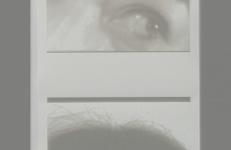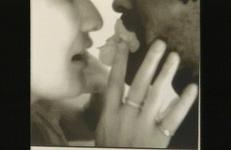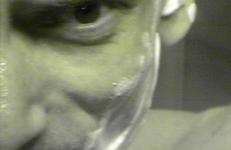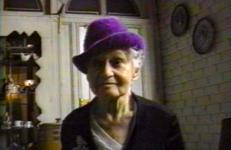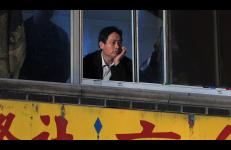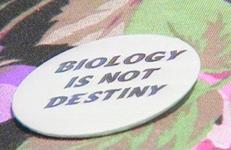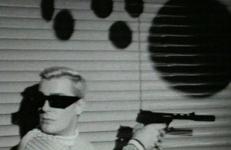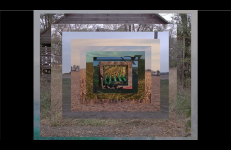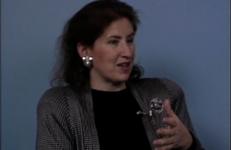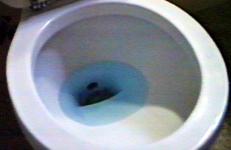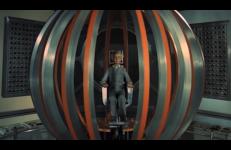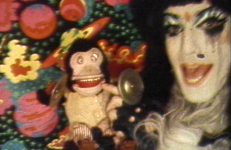This tape was originally an installation at the Whitney Museum of American Art, part of which included the video collaboration Channels of Desire. Recreating coin-operated porno booths, Channels aired one photo image on seven TVs, interrupted only by the viewer inserting a coin and choosing a segment. The concept behind it was the construction of desire in categorical ways, the form of the piece speaking to sexual desire as something that is constantly evading the viewer. The images present women’s experiences with interracial, lesbian, and heterosexual encounters.
LGBTQ
This video was originally an installation at the Whitney Museum of American Art, part of which included the video collaboration Channels of Desire. Recreating coin-operated porno booths, Channels aired one photo image on seven TVs, interrupted only by the viewer inserting a coin and choosing a segment. The concept behind it was the construction of desire in categorical ways, the form of the piece speaking to sexual desire as something that is constantly evading the viewer. The images present women’s experiences with interracial, lesbian, and heterosexual encounters.
“I am a mannish / Muff-diving / Size queen / With bad attitude / An arse-licking / Psychofag / Molesting the flies of privacy / Balling lesbian boys / A perverted heterodemon / Crossing purpose with death / I am a cock-sucking / Straight-acting / Lesbian man / With ball-crushing bad manners / Laddish nymphomaniac politics / Spunky sexist desires / Of incestuous inversion and / Incorrect terminology / I am a Not Gay”
—Derek Jarman, Blue: Text of a Film (Woodstock, N.Y.: Overlook Press, 1994)
A cinematic firestorm of found footage and pilfered Hollywood images, Mike Hoolboom’s hallucinatory Tom – described by the filmmaker as, "Cinema as déjà vu, or déjà voodoo" – pays mesmerizing experimental tribute to the life and work of friend and fellow avant-gardist Tom Chomont, and was selected by a national panel of film critics as one of Canada’s Top Ten of 2002.
A series of intimate video-8 vignettes depicting the fierce love between Malverna and Sandi, 88 and 22, grandmother and grandson. The two playmates dress up drag-esque for this moving portrait of a woman’s lifetime struggle with gender and sexuality. Since Malverna's death, Tomboychik has become a living memorial to the intensity of her spirit.
A man returns, after fifty years, to Chinatown to care for his dying mother. He is a librarian, a re-cataloguer, a gay man, a watcher, an impersonator. He passes his time collecting images that he puts before us – his witnesses and collaborators. Sitting in the dark, we share his cloak of invisibility, both a benefit and a curse.
Transexual Menace takes its title from the name of "the most exciting political action group in the USA"—transgendered people who are defining themselves, demanding their legal rights, and fighting for medical care and against job discrimination. Considered by von Praunheim to be the “most fascinating [project] in my long life as a filmmaker,” Transexual Menace is a sensitive and carefully crafted portrait that deals with issues openly and honestly. “I was able to earn the trust of many who are often reluctant to be interviewed.
In this interview, Los Angeles-based artist and filmmaker Ryan Trecartin (b. 1981) discusses his personal interests and motivations, as well as the larger cultural and philosophical concerns that shape his videos and their reception. Trecartin is known for his construction of non-linear narratives, campy costumes, and excessively visceral characters and environments. One of the most compelling aspects of this interview is his insistence that language and its verbal articulation, rather than the visual, anchor his process. Trecartin identifies the influences of 1990s retro-rave culture, hip-hop videos, and editing software tools on his work. He notes that the accelerated disintegration of high and low culture has played a major part in his growth as an artist.
TREYF “unkosher” in Yiddish— is an unorthodox documentary by and about two Jewish lesbians who met and fell in love at a Passover “seder”. With personal narration, real and imagined educational films, and haunting imagery, filmmakers Alisa Lebow and Cynthia Madansky examine the Jewish identity of their upbringings and its impact on their lives.
TREYF “unkosher” in Yiddish— is an unorthodox documentary by and about two Jewish lesbians who met and fell in love at a Passover “seder”. With personal narration, real and imagined educational films, and haunting imagery, filmmakers Alisa Lebow and Cynthia Madansky examine the Jewish identity of their upbringings and its impact on their lives.
In Two-Spirits Speak Out, Brenda and Glennda interview members of We'Wah and Bar-Chee-Ampe, one of the first Two-Spirit Native American organizations in New York. This episode addresses gender identity among Two-Spirit people, and discusses their involvement and experiences within the queer community in New York City.
Uh-Oh! is a love story that revolves around the classic text, The Story of O. Not an adaptation, but rather a critical analysis of masochism that investigates the relationship between love, risk-taking, spirituality, power, and sex. An all-female cast plays cowboys who stage sado-masochistic rituals in the basement of a diner. A waitress named Oh (Emanuela Villorini) falls in love with a cowboy (New York poet Eileen Myles).
A movie trailer for a non-existent Bond-style spy thriller "coming soon to a mini-mall cineplex near you!" Featuring John Sex, Hapi Phace, Laura Levine, Dany Johnson and The French Twist.
This title is also available on Tom Rubnitz Videoworks: Sexy, Wiggy, Desserty.
A girl with a bad habit of falling for older women befriends a boy lover. This video is an examination of relationships between adults and teenagers. It involves ice cream trucks and bowie knives.
A hug/punch eulogy for all things impossible now. Vague Images is a sketch book of images and sounds from the year wrapped around a trip out to Loomis, South Dakota to find the abandoned farm where my grandfather grew up. At the same time the film is a travelogue of my frustrations and understandings of gay sexuality. The two are connected.
Carole S. Vance is an anthropologist and writer and Associate Research Scientist of Public Health and Director of the Program for the Study of Sexuality, Gender, Health and Human Rights at Columbia University. She has written extensively on sexuality and public policy, as well as issues of gender, health, and medical anthropology. Her books include Pleasure and Danger: Exploring Female Sexuality (1984 and 1993) and Caught Looking: Feminism, Pornography, and Censorship (1988). Interview by Carole Tormollan. A historical interview originally recorded in 1989.
The comings and goings of the late underground filmmaker, Curt McDowell—and the people and activities that came and went along with him—are the themes that run through this existential diary of daily life. McDowell was dying from AIDS-related illnesses during the production of the diary.
“An elegy for McDowell, the videowork captures Kuchar’s mournful remembrances of his long-lasting friendship with the young filmmaker. But it also has the inquisitive charm, perverse humor, and quirky candor that places Kuchar’s visual expressions in a gritty niche all their own.”
PASSIONS run deep and LOVE flies high on Cupid’s arrow when ‘Boys’ are the desired target.
George goes to Oklahoma, but there's a lull in storm activity. It's spring, and though there's romance in the air, the lightning just doesn’t strike; so George makes his own rain—of sorts. Despite the drought, the videos must go on.
This title is also available on The World of George Kuchar.
Welcome to David Wojnarowicz Week is the follow up to A Boy Needs a Friend. Reinke proposes a new holiday with the motto MORE RAGE LESS DISGUST: David Wojnarowicz Week and takes us through his seven days of celebration.
This experimental documentary meditates on the space between two bodies and explores three key bodies in transition: the erotic "cruising" body, the transgender body, and the pregnant body.
This sumptuous Valentine sent by Miss Philly unfolds with the lavish lushness of love for HIM whom she adores.
This video was originally part of an installation at the Whitney Museum of American Art, part of which included the video collaboration Channels of Desire. Recreating coin-operated porno booths, Channels aired one photo image on seven TVs, interrupted only by the viewer inserting a coin and choosing a segment. The concept behind it was the construction of desire in categorical ways, the form of the piece speaking to sexual desire as something that is constantly evading the viewer. The images presented women’s experiences with interracial, lesbian, and heterosexual encounters.
In Wigstock ’94, Glennda and her friend Bobra attend Lady Bunny’s Wigstock festival. Following the event’s move from the East to the West Village, they explore the changing dynamics and configurations of queer culture in New York. The pair interview other drag queens, members of the local community, and passersby to get a sense of how an event like Wigstock is received by the city.
An episode of Glennda and Friends, hosted by Glennda Orgasm and Bobra. Featuring Jackie Beat, Joan Crawford, Jackie O., Sherry Vine, Nona Vulva, Wendy Wild, and Yumi.
Rubnitz’s tape celebrates and documents an early installment of the “storywig-in,” shot nearly a decade before the feature-length documentary. Presenting the festival during its Tompkins Square Park era, when the 1960s themes were still played up, the tape combines live performance footage with off-stage interviews and music video reverie. Featuring The “Lady” Bunny, Lypsinka, Frieda, John Sex, John Kelly, Baby Gregor, Hapi Phace, Taboo, and many others.




